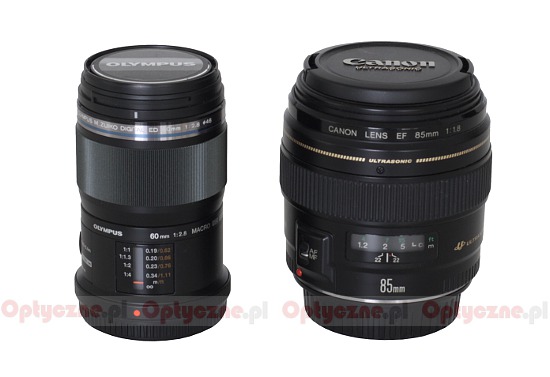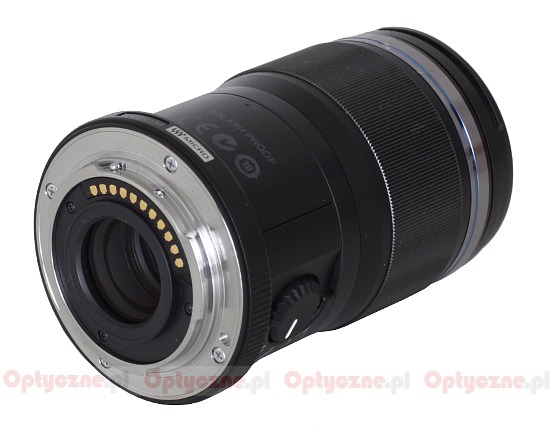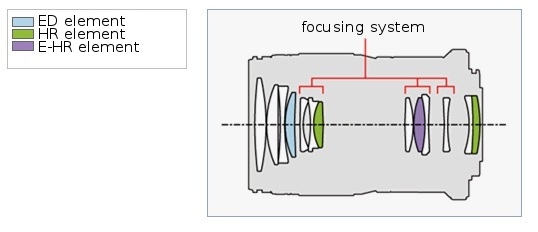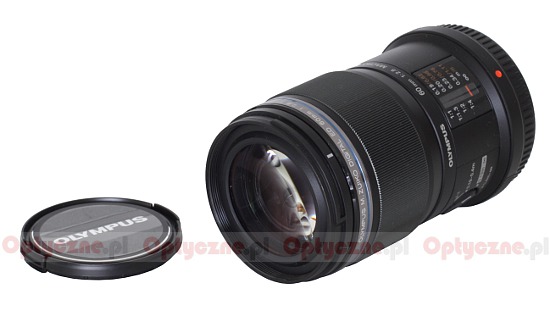Olympus M.Zuiko Digital 60 mm f/2.8 ED Macro
3. Build quality
Other mirrorless systems don’t feature any macro lenses which would be a full frame equivalent of a focal length longer than 100 mm; still in the Fujifilm X and Samsung NX systems feature macro devices with a focal length of exactly 60 mm and the Olympus, tested here, can be compared to them as well. You should remember, though, that those lenses give a bit wider angle of view. This chart shows that the Olympus is, once again, the smallest of all.
In the photo below the Olympus M.Zuiko Digital 60 mm f/2.8 ED Macro is positioned next to the Canon EF 85 mm f/1.8 USM.
Please Support UsIf you enjoy our reviews and articles, and you want us to continue our work please, support our website by donating through PayPal. The funds are going to be used for paying our editorial team, renting servers, and equipping our testing studio; only that way we will be able to continue providing you interesting content for free. |
- - - - - - - - - - - - - - - - - - - - - - - - - - - - - - - - - - - - - - - - - - - - - - - -
 |
The tested lens starts with a metal mount which surrounds contacts and a rear immobile element with a diameter of almost 20 mm. The element is situated almost on the same level as the mount.
 |
The proper barrel of the lens starts behind a ring which becomes wider further on and has a red dot, making the alignment to a camera easier; it is also partially ribbed which is supposed to ensure a better grip.
Then there is a distance scale, expressed in meters and feet, joined with a reproduction ratio scale. Contrary to most of other lenses the scale marker doesn’t move sideways but along the body of the lens. On the left side of the scale you can find a focusing mechanism limiter switch. You can choose between the following ranges: from 0.19 to 0.40 of a meter, from 0.19 to infinity, from 0.4 to infinity and the 1:1 marker which shifts the scale to the minimum sharpening distance with 1:1 reproduction ratio. It’s worth emphasizing here that if the magnification is 1:1 the photographed object is situated in the distance of 7 cm from the front element. Opposite to the scale you can find a “SPLASH PROOF” inscription meaning that the lens can stand being splashed by a little water.
 |
Behind the distance scale there is another narrow and immobile ring on which you can find the name and parameters of the lens. Immediately behind it you can see a manual focus ring, 31 mm wide, the majority of which is covered by fine ribs. The ring is electronic with a step is so small that running through the whole distance scale takes a turn through a huge angle of 1200 degrees.
The next part of the tube is another narrow and immobile ring, shiny for a change, adorned by a blue stripe with the name and the parameters of the lens. Then you find a hood mount which surrounds a motionless filter thread, 46 mm in diameter. The front element has a diameter of 32 mm and is immobile as well.
 |
The optical construction of the tested lens consists of 13 elements positioned in 10 groups. The producer boasts of using one low dispersion ED glass and three elements with a high light refraction index (two HR and one E-HR elements). Inside you can also find an aperture with seven diaphragm blades which can be closed up to the value of f/22. Olympus also mentions using ZERO multi layers (ZUIKO Extra-low Reflection Optical) which are supposed to be two times as efficient as conventional coatings when it comes to dampening flares.
Unfortunately the standard accessory kit of the lens is very modest indeed – it consists of just the caps. However the producer encourages you to buy other accessories like the Olympus LH-49 hood, the Olympus PRF-D46 PRO protective filter, the LSC-0814 case, TF-22 or RF-11 macro flashes or the FR-2 flash adapter ring.
 |






